The average cost to repair or replace a roof in the United States can range from $15,000 to over $27,000, depending on where the home is located, the type of materials used, and the size of the roof.
These costs have shot up nearly 30% since 2022, with repairs and replacements across the country totaling almost $31 billion in 2024. That’s a pretty big jump, and it really highlights how expensive it’s getting just to keep your house safe and dry.
Homeowners might be surprised by how much prices can change depending on whether they live in the Northeast, Midwest, South, or West. The specific climate risks in their area also play a big part.
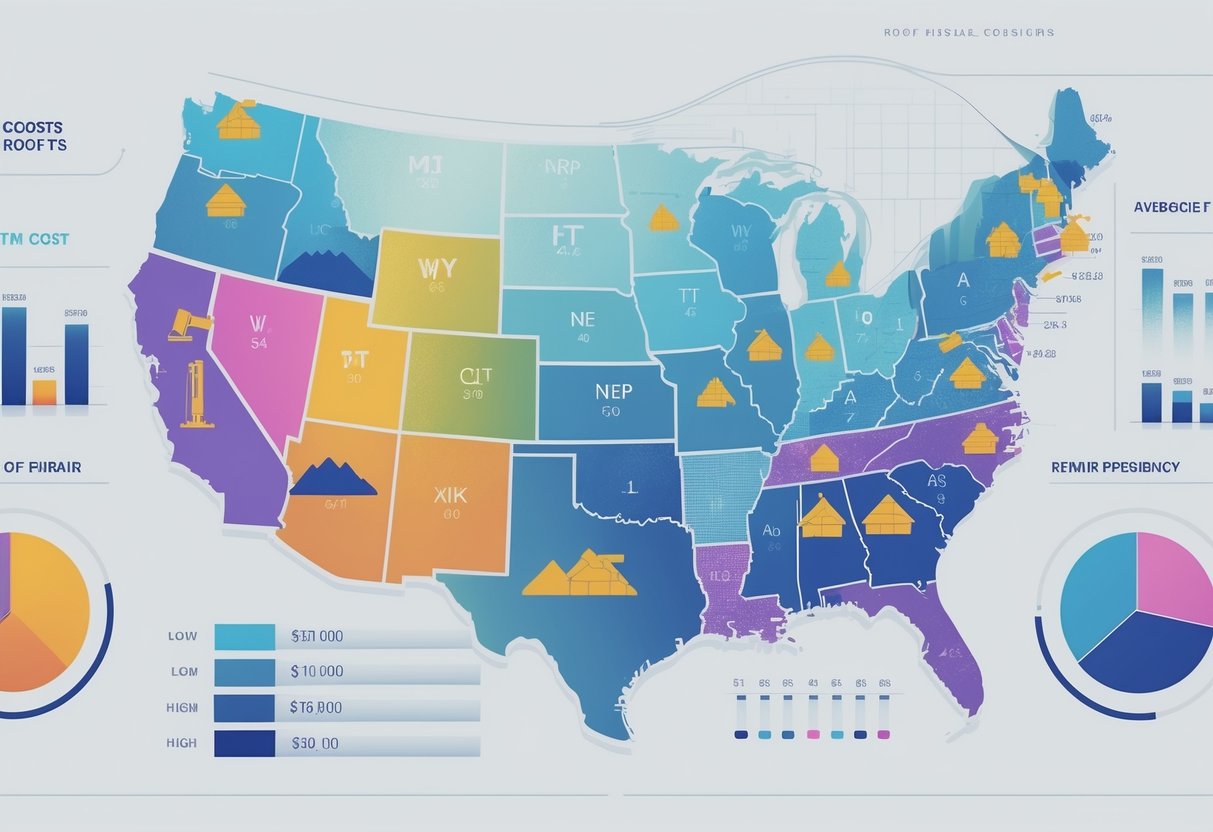
Roofing material choices, labor costs, and storm frequency all have a big impact on what you’ll end up paying. If you’re in a place with a lot of hail or strong winds, expect those repair bills to climb.
Need a Home Fix – Emergency or Routine?
From leaks and no-heat nights to simple tune-ups, our 24/7 hotline connects you with trusted local pros in minutes.
Insurance might cover some of these expenses, but it’s always a good idea for homeowners to know what factors affect their final cost. That way, they can plan and budget without too many surprises.
Key Takeaways
- Roof repair costs vary widely based on region and materials.
- Labor and local weather strongly affect total expenses.
- Knowing cost factors helps with smart planning and budgeting.
Understanding Roof Repair Costs in the United States
Roof repair costs in the United States depend on the size of the repair, the type of damage, the materials used, and the region. Homeowners should think about both the immediate expense and the long-term value before deciding whether to repair or replace their roof.
Overview of Average Roof Repair Cost
The average roof repair cost across the United States usually falls between $300 and $1,200 for most minor to moderate jobs.
Nationally, the typical homeowner pays about $650 to $850 per repair. Prices can swing quite a bit depending on where you live.
If you’re in an area with high labor rates or pricey materials, expect to pay at the top end of that range. Common repairs include fixing leaks, replacing shingles, dealing with flashing, or repairing vent boots.
More complex work, like fixing sagging sections, might run from $1,000 up to $4,000. That’s not even counting tricky situations like steep or multi-story roofs, which can push costs higher.
Find more details on average roof repair costs.
Key Factors Influencing Roof Repair Costs
Several things shape the final bill for roof repair. Type of damage is a big one—patching a small leak or swapping a few shingles is way cheaper than dealing with sagging or structural issues.
Material choice matters too. Asphalt shingles are pretty affordable to fix, but slate, clay tiles, or metal? Not so much.
Labor costs depend a lot on location and the time the job takes. Roofs with tricky designs, lots of layers, or steep pitches are just harder to work on, so labor and safety costs go up.
Don’t forget about permit fees and local building rules—they can sneak up on you in certain cities or states.
Weather and season can also nudge prices up, especially if you need emergency repairs after a storm or during the busy season. You can get a breakdown of these costs at DIY Roofing USA.
Comparing Roof Repair and Roof Replacement
Choosing between repair and replacement isn’t always simple. Roof repair makes sense for minor, isolated problems or newer roofs with plenty of life left.
If the issues are widespread or your roof’s getting old, a full roof replacement might be smarter in the long run. Replacement costs are much higher, and they vary by region.
Typical costs in 2023 ranged from $6,000 to $16,000, with the South usually being the cheapest and the West the priciest. Material choice really matters here—metal and tile roofs cost more than asphalt shingles.
Homeowners should look at their ongoing repair bills versus the cost of a full replacement to figure out what makes the most sense for them. Compare roof replacement costs by region at RakeML’s analysis of roof costs.
Regional Variations in Roof Repair Costs
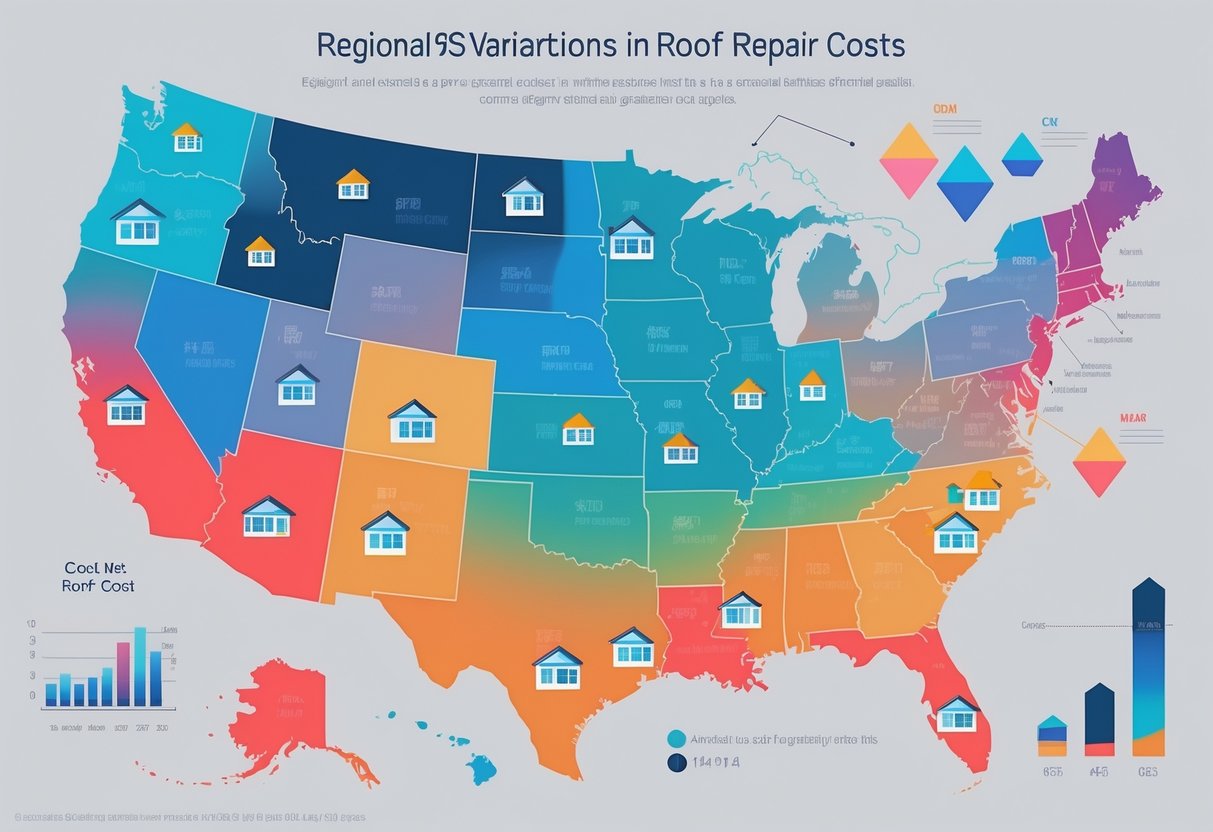
Roof repair prices change a lot across the United States. The region’s labor rates, local rules, and the types of damage that happen most often all play a part.
Cost Differences by Region
Labor and material costs really depend on where your house is. In the Northeast and on the West Coast, repair costs are often higher because labor is expensive and the rules are strict.
Big cities and urban spots can see prices up to $4,000 for major repairs. Rural areas and the South tend to be cheaper, with typical repairs running from $400 to $1,500.
Still, if you need special materials or you’re in a storm-prone area, prices can climb. Most repairs in the U.S. land between $800 and $2,500, but extreme weather or unusual roof types can push some jobs up to $3,000 or more.
Impact of Local Building Codes
Local building codes can have a direct effect on repair costs. Some states require certain roof materials or building methods to meet weather or fire safety rules.
Take Florida, for example—hurricane protection is a big deal. Roof repairs there have to use stronger materials and meet wind resistance standards, which bumps up both labor and material costs.
In California, fire codes might mean you need specific shingles and underlayment, making repairs pricier. Some cities also require permits for every repair, adding fees and delays.
All these things can lead to big cost differences for the same kind of repair, depending on where you live.
Common U.S. Roof Claims by Location
The most common roof damage claims really depend on local risks. Along the Gulf Coast and in the Southeast, wind and hail damage are huge—especially during hurricane season.
These areas usually see higher insurance payouts and repair costs because the damage is often severe. In the Midwest, hail and tornadoes top the list for roof claims.
Out West, wildfire and earthquake zones shape the repairs you’ll see most often, with fire and smoke damage claims especially high in California. A national study found that storm, wind, and hail damage make up most roof insurance claims, driving up repair costs in disaster-prone spots.
Types of Roofing Materials and Their Costs
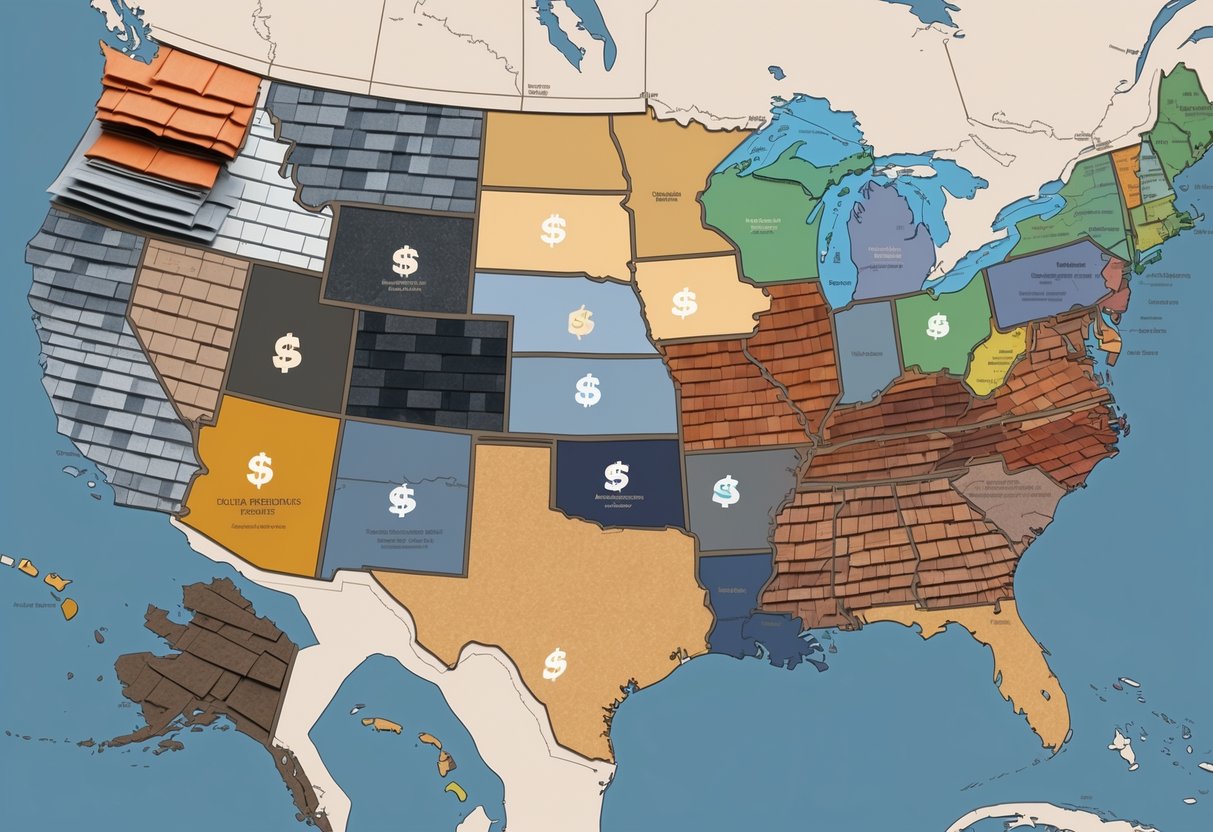
The cost of a roof repair really depends on the type of roofing material you have. Different materials come with different lifespans, installation costs, and benefits, and what works best can vary a lot across the country.
Asphalt Shingles: The Most Popular Choice
Asphalt shingles are still the top pick for most homes. They’re affordable, easy to find, and come in three main types: 3-tab shingles, architectural (dimensional) shingles, and premium (designer) shingles.
- 3-tab shingles usually cost between $1 and $2 per square foot and last about 15 to 20 years.
- Architectural shingles are thicker and more durable, costing $2 to $5 per square foot, with lifespans of 20 to 30 years.
- Premium shingles can go beyond $5 per square foot and are built to last even longer.
People often pick asphalt shingles because they’re quick to install, which makes repairs faster and less expensive. For more info, check out this guide to roofing material costs.
Metal Roofs and Metal Roofing
Metal roofing is getting more popular thanks to its durability and energy efficiency. The main materials include steel, aluminum, copper, and zinc.
Metal roofs usually cost more up front than asphalt but can last 40 to 70 years. Prices range from $5 to $14 per square foot, depending on the metal and style.
While you’ll pay more for installation, metal roofs can help lower your energy bills because they reflect heat. They’re also tough—good against severe weather, fire, rot, and insects.
For a closer look at metal roofing costs, see this roofing material analysis.
Concrete Tiles and Other Roofing Options
Concrete tiles are known for their strength and long lifespan, often lasting over 50 years. They cost between $4 and $9 per square foot.
Installation is more complicated because of their weight, so you might need extra roof support. Other materials, like clay tiles and slate, are pricier but offer great durability and a distinct look.
These materials show up more in certain regions or architectural styles. When thinking about concrete tiles or alternatives, consider the structure of your home, the local weather, and the style you want.
For more on costs, check out guides about roofing materials and their costs.
Labor Costs and Roofing Services
The total price of roof repair depends on a few key things, but labor costs and the kind of roofing service you choose are definitely at the top of the list. Knowing how these work can help homeowners and property managers make smarter choices when it’s time for repairs.
How Labor Costs Affect Roof Repair Pricing
Labor costs often make up a big chunk of the overall price for roof repairs. Rates can vary a lot depending on the region, how much demand there is, and the experience of the crew.
Roofers might charge by the hour or by the size of the job, like per square foot. For most repairs, labor is about 60% of the total bill.
In places with a higher cost of living, rates are usually steeper. The average roofing salary is around $40,088, which shows how labor can drive up repair and replacement prices.
If the job is complex, an emergency, or the roof has a steep or tricky design, expect labor hours to increase. Weather can also mess with timing and cost—delays or extra equipment might be needed if the climate’s rough.
For more on how wages impact the industry, check out these roofing statistics.
Choosing the Right Roofing Services
Picking the right roofing service can actually save you a lot down the line. Homeowners should always look for contractors who are experienced, licensed, and insured.
Different roof repairs need different skills and materials. Not every roofing company offers all the services, so it pays to check first.
It’s smart to compare quotes from a few providers. Some companies use advanced calculators to estimate both materials and labor, giving you a clearer sense of costs—like what you’ll find at RoofRepairRates.com.
Ask about warranties, how long repairs will take, and dig into reviews or ratings. It doesn’t hurt to do a little homework before signing anything.
Clear communication with your contractor helps make sure you get the right services and keeps surprise costs at bay. If you can, go with a reputable company that specializes in your type of repair. It just makes everything smoother.
Additional Factors Influencing Roof Repair Costs
Lots of things can mess with what you’ll pay for roof repairs. The age of your roof, special features like cool roofs, and damage from storms all play a part.
Effects of Roof Lifespan and Aging
Older roofs? They wear out, and that means repairs get more likely—and sometimes pricier. Shingles can crack or curl, and the underlayment might weaken over time.
If your roof’s pushing 20-25 years for asphalt or 40-70 for metal, patching one spot may not keep new problems from showing up. Old roofs often hide water damage or rotting wood, which can slow things down for contractors.
Sometimes, replacing the whole thing is just a better call than endless repairs. If you want more details, check out this roof repair guide.
Cool Roofs and Energy Efficiency
Cool roofs are built to bounce sunlight and absorb less heat, which helps with cooling bills. But repairing them can cost more since you might need special materials or coatings.
Some repairs mean adding or restoring reflective surfaces, which regular roofs don’t have. In states with energy-saving incentives, fixing up a cool roof might even get you a rebate.
The main costs come from unique materials and extra labor, but there’s a payoff in energy savings. Want more specifics? There’s a good summary of key roof repair factors.
Hail Damage and Weather-Related Repairs
Hail storms can punch holes in roofing, dent metal, and split shingles. Bad weather often means emergency repairs, which usually cost more if you need them fast to stop leaks.
Repairs after hail can mean replacing big sections, fixing gutters, or checking underlayment for hidden moisture. Insurance might help, but deductibles and limits can affect what you pay out of pocket.
Every storm leaves its own mark, so the repair process and price can swing a lot. Here’s a detailed look at roof storm damage if you’re curious.
Financing and Payment Options for Roof Repairs
Paying for roof repairs can be tough, especially since a new roof often runs between $5,500 and $11,000. Not many folks have that kind of cash just sitting around.
Financing options can help break up those big bills.
Common ways to finance roof repairs include:
- Personal loans: Unsecured loans with fixed monthly payments.
- Home equity loans or lines of credit: Use your home’s equity for lower rates.
- Credit cards: Fast, but usually higher interest.
- Contractor financing: Some roofers offer payment plans.
- Government programs or grants: If you qualify, these can help.
Here’s a quick comparison:
| Option | Typical Interest Rate | Approval Time | Special Notes |
|---|---|---|---|
| Personal Loan | 6% – 36% | 1-7 days | No collateral needed |
| Home Equity Loan/HELOC | 4% – 10% | 1-4 weeks | Lower rates, uses home as collateral |
| Credit Card | 18% – 25%+ | Instant | High interest, risk of debt |
| Contractor Financing | Varies | Varies | May offer promotional rates |
Interest rates, loan terms, and eligibility all depend on the lender and your credit. For more info, check these overviews of roof repair financing options and best roof financing choices.
What’s best for you really depends on your credit, home equity, and budget. Shop around before you decide.
Frequently Asked Questions
Roof repair costs in the U.S. swing a lot based on roof size, type of damage, materials, and labor. Prices range from small leak fixes to full replacements, and regional differences or market changes can really shift the numbers.
What is the average cost to replace a roof on a residential property in the United States?
For a typical home, replacing a roof averages about $11,500. Most folks spend between $6,700 and $80,000 in 2025, depending on house size and the materials used. More stats are over at average roof replacement cost.
How is the cost of roof repair typically calculated per square foot?
Roof repair prices are usually figured by the square foot. Labor, materials, and old roof removal are all included in the total.
Rates change based on the roofing material and how bad the damage is. Asphalt shingles are usually cheaper per square foot than metal or tile.
What factors contribute to the overall cost of major roof repairs?
Major repairs can mean replacing trusses, rafters, or underlayment. Costs climb if structural issues or water damage pop up.
Location, roof height, pitch, and materials all play a role. Labor shortages or high demand in some areas can raise prices, too.
Can you provide a cost range for fixing a minor roof leak?
Fixing a minor roof leak usually runs between $360 and $1,550. Skylight or vent leaks are often cheaper—skylight repairs might cost $300 to $800.
There’s more info here about roof leak repair costs.
What expenses should be considered when estimating roof rafter repair costs?
You’ll need to factor in both material and labor costs. Estimates can run from $500 to $5,000 for truss repair or replacement.
Getting to the damaged area, roof type, and how bad the structural problems are can all change the final bill. There’s a good breakdown in this roof replacement cost guide.
How much should a comprehensive roof inspection cost in the United States?
A basic roof inspection usually runs between $75 and $200. The price can shift depending on your home’s size, the roof’s style, and even where you live.
Some contractors might throw in a free inspection if you end up hiring them for repairs. If you need a more advanced or certified inspection, expect the cost to go up.
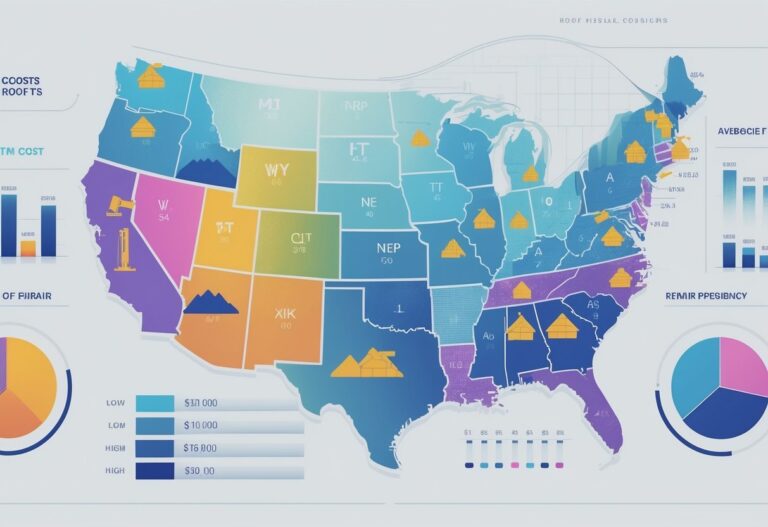




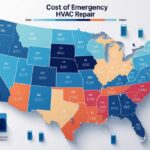

Leave a Reply